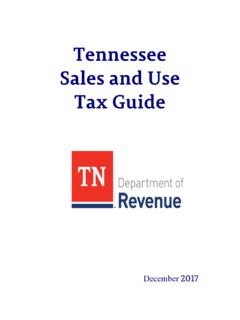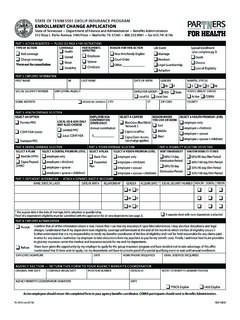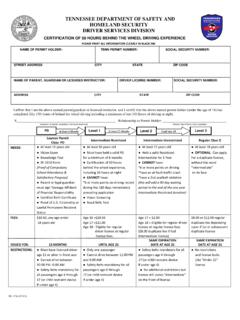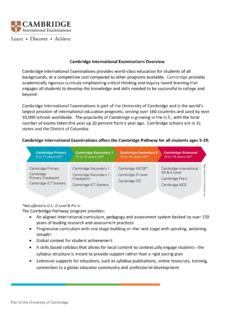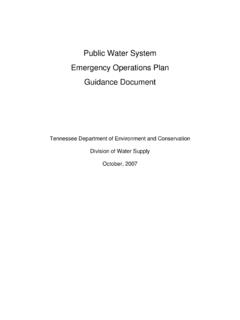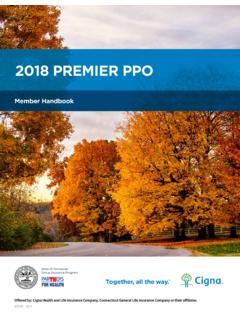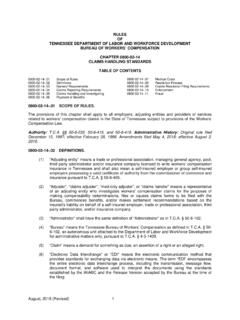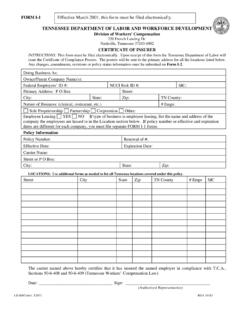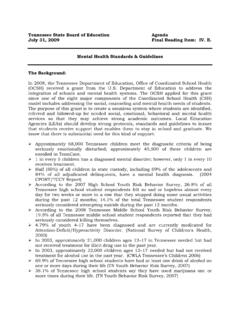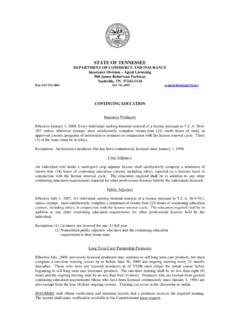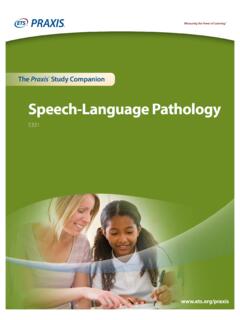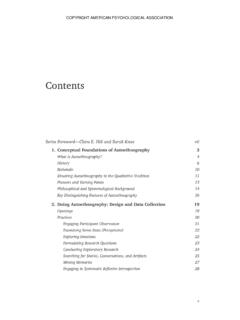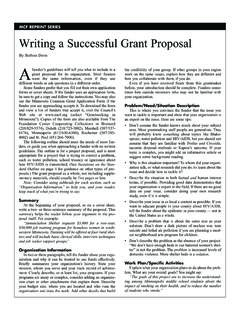Transcription of Supporting Long-Term English Learners
1 English Learners A guide Tennessee Department of Education | August 2018 Supporting Long-Term Contents 3 Guiding Principles .. 3 Landscape .. 4 Characteristics of LTELs .. 6 Background Context on LTELs .. 6 6 LTEL Influencing Factors .. 7 Phases of Language Acquisition .. 7 Promising Practices .. 7 Course 8 Authentic 9 Academic 9 Cultural 10 Individual Learning Plans (ILPs) .. 10 Social and Personal Competencies .. 11 Student Profiles: Promising Practices in 12 Next Steps - 14 Conclusion .. 14 References .. 15 2 Introduction The purpose of this document is to provide research and promising practices on how to support Long-Term English Learners (LTELs).
2 Tennessee defines a Long-Term English learner as a student who receives English as a second language (ESL) services for longer than six years. An EL becomes an LTEL when they enter into the seventh year of ESL services. As the department has outlined in the resource Supporting All English Learners Across Tennessee: A Framework for English Learners , it is imperative that we develop and implement a rigorous plan to support ELs to ensure that all students are given the opportunity to fulfill their chosen path in life. This guide is designed to support districts, schools, and educators in having conversations around their LTELs and developing and strengthening plans to support language and content acquisition. In order to ensure ELs are ready to graduate and be successful in postsecondary and workforce opportunities, the goal of Tennessee schools must be to move ELs through the program within 5-6 years, and even sooner for those entering at an early age.
3 The Department of Education has a toolkit for ELs and another for newcomers online at English Learner Toolkit and Newcomer Toolkit. Guiding Principles All of the guiding principles listed below support the department s Tennessee Succeeds vision that ALL students should be prepared for postsecondary and the workforce. Tennessee commits to ensuring that ELs are equipped with the knowledge, skills, and habits to be successful in their chosen path in life. We believe LTELs should be provided the appropriate differentiation, accommodation, and scaffolding to be able to access the correct grade-level Tennessee Academic Standards. We believe LTELs in middle school and high school should, wherever possible, be provided the opportunities to participate in electives based on academic interests.
4 We believe LTELs should be part of the conversation around personal goal setting and individual academic data. We believe LTELs can exit ESL services and take advantage of early postsecondary opportunities in high school. We believe LTELs must have access to strong Tier I core instruction. 3 - -Landscape Tennessee s EL population has seen dramatic growth over the past six years with 132 of the 147 districts in the state serving at least one EL in 2016-17. Out of the 52,000 ELs in 2016-17, 13 percent are LTELs.
5 In order for a student to be classified as a LTEL they must be in their seventh year of receiving ESL services; therefore, all LTELs must be in grades 6-12. Chart 1 below illustrates that 41 percent of ELs in grades 6-12 are LTELs. On average, LTELs have been receiving ESL services for eight years. Chart 1 Chart 2 9,184, 59% 6,283, 41% ELs in Grades 6-12 Not LTEL LTEL 12% 7% 29% 0% 20% 40% % SWD Percent SWD by LTEL Status EL Grades K-5 Not LTEL Grades 6-12 LTEL Chart 2 highlights the percent of ELs who are dually classified as a student with disabilities (SWD). Seven percent of non-LTEL ELs and 29 percent of LTELs are dually identified as a student with disabilities. This important data point highlights that some students who are LTELs may also have an additional support structure that is needed through an IEP, but the data clearly shows not all LTELs are students with disabilities.
6 Tennessee data also reveals that LTELS have lower chronic absenteeism rates than their non-LTEL peers and have rates similar to non-EL students. Fifteen percent of non-ELs are chronically absent, percent of non-LTEL ELs are chronically absent, and percent of LTELs are chronically absent. This shows that chronic absenteeism is not a major contributing factor to a student being a LTEL. 4 of former English Learner students Students who have exited EL services often outgrew all students 3-5 ELA 3-5 Math High School Math History II Department of -All Students -Former EL Students The 2017-18 TNReady scores for ELs show that the full English learner student group, which includes recently exited students, narrowed the gap with their non-EL peers in both math and English language arts (ELA), with an across-the-board increase in the percent of EL students scoring on track and mastered.
7 Additionally ELs who have exited ESL services outgrew all students in percent of students on track or mastered on TNReady (Chart 3). For grades 3- 5 ELA, percent of all students improved in percent of on track or mastered whereas percent of ELs improved. This trend continued across 3-5 math, high school math, and History. This exciting and impactful data shows that the tremendous work across the state should be celebrated and used as motivation to continue to push ourselves in this work. Chart 3 5 Characteristics of LTELs Long-Term English Learners have unique language challenges that necessitate a differentiated approach to Supporting language acquisition and content LTELs often function socially in English and their home language but may lack the deeper levels of vocabulary, syntax, and grammar in order to successfully exit an ESL program.
8 LTELs are often performing at the intermediate levels on the WIDA Access and may have been for multiple years. LTELs may have a significant deficit in one of the four areas of the WIDA Access ( reading , writing, speaking, and listening), and it is often the productive skills of speaking and writing that present the largest barriers. LTELs may have developed coping mechanisms to hide their challenges with the English language, such as being reluctant to speak in whole group settings. LTELs may require additional supports outside of English language acquisition such as social and personal development or study skills. LTELs are at a greater risk of dropping out of school, as they may not see school as a place where they can be successful. LTELs are often ELs who were retained in a grade level.
9 Background Context on LTELs Research Exiting after the sixth year of ESL services falls within the range supported by seminal research on EL proficiency. However, educators should consider on an individual basis how this rate of growth can be improved through differentiated instruction. Current data reveals that students with lower English proficiency grow faster, and those with higher proficiency grow These data, however, can be affected by more dynamic and tailored instruction. ESL teachers often document older students who exit and are proficient in two to four years. Many factors influence growth results: Student experience learning another or other languages Student literacy in his or her first language (L1) Student access to formal education Interruptions to the student s formal education Evidence that classroom Tier I core instruction is differentiated EL ability to compare L1 and L2 and analyze the language similarities and differences 6 LTEL Influencing Factors Although the factors for a student becoming a LTEL vary greatly, below are the most commonly documented reasons.
10 Iv LTELS, in the course of their educational career, may not have received appropriate, rigorous English language instruction. LTELs may not have been held to high expectations. LTELS may have received inconsistent ESL program instruction. LTELs may have not had strong instruction in foundations of early literacy to authentic language. LTELS may not have experienced differentiation and scaffolding as needed. High-quality, consistent, and differentiated instruction grounded in authentic language experiences can provide a necessary foundation to support English Learners and prevent them from receiving ESL services for more than six years. Phases of Language Acquisition An important point for Supporting language acquisition for ELs, and especially for LTELs, is ensuring that students are gaining the two types of language skills: Basic Interpersonal Communication Skills (BICS) and Cognitive Academic Language Proficiency (CALP).
